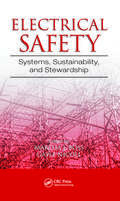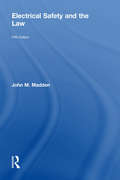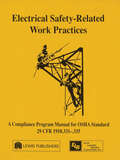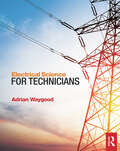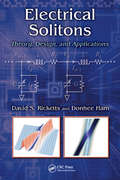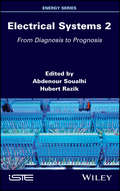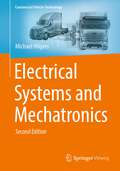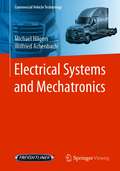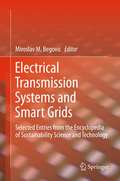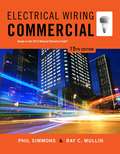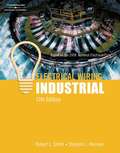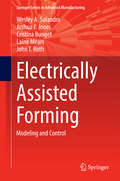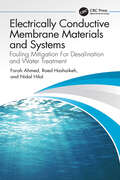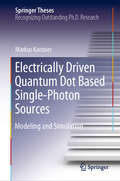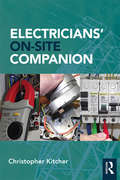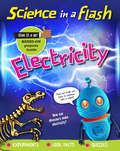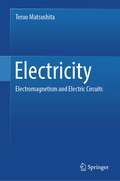- Table View
- List View
Electrical Safety: Systems, Sustainability, and Stewardship
by Martha J. Boss Gayle NicollLearn How to Implement Safety Codes and Regulations EffectivelyA number of electrical fatalities and injuries that occur each year can be overcome by a thorough understanding of electrical concepts. Yet due to the complexity of regulatory requirements, many safety professionals may not be fully equipped to handle the task. Electrical Safety: System
Electrical Safety and the Law: A Guide To Compliance
by John M MaddenElectrical Safety and the Law describes the hazards and risks from the use of electricity, explaining with the help of case studies and accident statistics the types of accidents that occur and how they can be prevented by the use of safe installations, equipment and working practices. It describes the British legislation on the safety of electrical systems and electrotechnical machinery control systems, much of which stems from European Directives and which will therefore be affected by the UK’s decision to leave the EU (Brexit), and the main standards and guidance that can be used to secure compliance with the law. There are detailed descriptions covering the risks and preventive measures associated with electrical installations, construction sites, work near underground cables and overhead power lines, electrical equipment and installations in explosive atmospheres, electrical testing and electrotechnical control systems. Duty holders’ responsibilities for designing, installing, and maintaining safe systems are explained, as well as their responsibilities for employing competent staff. The fifth edition has been substantially updated to take account of considerable changes to the law, standards and guidance; it has been expanded to include: a new chapter on the Corporate Manslaughter and Corporate Homicide Act; a new chapter describing landlords’ legal responsibilities for electrical safety in private rented properties and social housing; a new chapter on the Electricity Safety Quality and Continuity Regulations; new information on offences, penalties, sentencing guidelines, and relevant case law; a description of the main requirements of BS 7671:2008 and other principal standards, many of which have been amended in recent years; new cases studies to illustrate the hazards and risks; information on changes to GB’s health and safety system.
Electrical Safety-Related Work Practices: OSHA Manual
by Richard EnnisElectrical Safety-Related Work Practices is a complete training package that describes 29 CFR 1910.331-.335, OSHA's Electrical Safety-Related Practices Standard, and outlines the requirements for training employees exposed to electrical hazards. The program presents a thorough overview of electrical safety as it applies to the standard. Topics covered include electrical accidents, qualified and unqualified persons, employee training, work practices covered by the standard, protective equipment, and protective shields and barriers. A complete implementation plan, standard checklists, a summary of the standard, and a copy of OSHA's "Illustrated Guide to Electrical Safety" are provided in addition to a sample employee training booklet. Electrical Safety-Related Work Practices is the perfect training tool for risk managers, safety managers, line production supervisors, engineers, and maintenance workers affected by this OSHA standard.This complete training package contains implementation/compliance manual, VHS tape, employee training booklet.
Electrical Science for Technicians
by Adrian WaygoodAn indispensable resource for electrical technicians and trainees, Electrical Science for Technicians walks readers through the subject in a logical order, providing a historical overview alongside modern electrical theory and practice. You will be guided through the subject in a topic by topic manner with each section building upon the one that came before it. By adding context to the principles of electrical science they become easier to both understand and remember, providing a background in the subject that will remain with you for life. Fully aligned to the 17th edition of the wiring regulations Topic-based approach ensures suitability for both technicians and students Clear objectives outlined at the start and revisited at the end of each chapter as a checklist allow readers to check their learning before moving on.
Electrical Solitons: Theory, Design, and Applications (Devices, Circuits, and Systems)
by David S. Ricketts Donhee HamThe dominant medium for soliton propagation in electronics, nonlinear transmission line (NLTL) has found wide application as a testbed for nonlinear dynamics and KdV phenomena as well as for practical applications in ultra-sharp pulse/edge generation and novel nonlinear communication schemes in electronics. While many texts exist covering solitons in general, there is as yet no source that provides a comprehensive treatment of the soliton in the electrical domain. Drawing on the award winning research of Carnegie Mellon’s David S. Ricketts, Electrical Solitons Theory, Design, and Applications is the first text to focus specifically on KdV solitons in the nonlinear transmission line. Divided into three parts, the book begins with the foundational theory for KdV solitons, presents the core underlying mathematics of solitons, and describes the solution to the KdV equation and the basic properties of that solution, including collision behaviors and amplitude-dependent velocity. It also examines the conservation laws of the KdV for loss-less and lossy systems. The second part describes the KdV soliton in the context of the NLTL. It derives the lattice equation for solitons on the NLTL and shows the connection with the KdV equation as well as the governing equations for a lossy NLTL. Detailing the transformation between KdV theory and what we measure on the oscilloscope, the book demonstrates many of the key properties of solitons, including the inverse scattering method and soliton damping. The final part highlights practical applications such as sharp pulse formation and edge sharpening for high speed metrology as well as high frequency generation via NLTL harmonics. It describes challenges to realizing a robust soliton oscillator and the stability mechanisms necessary, and introduces three prototypes of the circular soliton oscillator using discrete and integrated platforms.
Electrical Systems 2: From Diagnosis to Prognosis
by Abdenour Soualhi Hubert RazikMethods of diagnosis and prognosis play a key role in the reliability and safety of industrial systems. Failure diagnosis requires the use of suitable sensors, which provide signals that are processed to monitor features (health indicators) for defects. These features are required to distinguish between operating states, in order to inform the operator of the severity level, or even the type, of a failure. Prognosis is defined as the estimation of a system's lifespan, including how long remains and how long has passed. It also encompasses the prediction of impending failures. This is a challenge that many researchers are currently trying to address. Electrical Systems, a book in two volumes, informs readers of the theoretical solutions to this problem, and the results obtained in several laboratories in France, Spain and further afield. To this end, many researchers from the scientific community have contributed to this book to share their research results.
Electrical Systems and Mechatronics (Commercial Vehicle Technology)
by Michael HilgersThe aim of this work, consisting of 9 individual, self-contained booklets, is to describe commercial vehicle technology in a way that is clear, concise and illustrative. Compact and easy to understand, it provides an overview of the technology that goes into modern commercial vehicles.Starting from the customer's fundamental requirements, the characteristics and systems that define the design of the vehicles are presented knowledgeably in a series of articles, each of which can be read and studied on their own. This volume, Electrical Systems and Mechatronics, offers an introduction to the mechatronics in a commercial vehicle. The electrical and electronic systems are presented, up to and including the advanced driver assistance systems. The compressed air system and the commercial vehicle brake are explained to give the reader a comprehensive overview, such as is helpful for understanding in training and in practice.
Electrical Systems and Mechatronics (Commercial Vehicle Technology)
by Michael Hilgers Wilfried AchenbachThe aim of this work, consisting of 9 individual, self-contained booklets, is to describe commercial vehicle technology in a way that is clear, concise and illustrative. Compact and easy to understand, it provides an overview of the technology that goes into modern commercial vehicles.Starting from the customer's fundamental requirements, the characteristics and systems that define the design of the vehicles are presented knowledgeably in a series of articles, each of which can be read and studied on their own. This volume, Electrical Systems and Mechatronics, offers an introduction to the mechatronics in a commercial vehicle. The electrical and electronic systems are presented, up to and including the advanced driver assistance systems. The compressed air system and the commercial vehicle brake are explained to give the reader a comprehensive overview, such as is helpful for understanding in training and in practice.
Electrical Transmission Systems and Smart Grids
by Miroslav M. BegovicElectric transmission networks are among the largest human-made engineering systems: For example, the transmission network in the United States covers over 300,000 km of lines and is served by 500 companies (electric utilities). In sharp contrast to the very incremental developments of the last century, transmission and control technologies experienced a major breakthrough at the beginning of the 21st century. The rapid growth of new energy generation technologies (renewables), significant advances in information processing applied to system monitoring, planning, operation, control, and protection, radical changes in distribution networks, and key shifts in end user behavior (advanced metering and control of demand response) have combined to produce the modern integrated electrical infrastructure commonly referred to as the smart grid. Featuring state-of-the-art, peer-reviewed entries from the Encyclopedia of Sustainability Science and Technology, this book provides a detailed introduction to select key topics which span energy technology, engineering, and urban planning. Worldwide experts discuss the integration of electric energy infrastructure into the broader critical infrastructures of the modern world and their various interdependencies. Dedicated chapters cover specific topics ranging from underground transmission and distribution, to energy and water interdependence, and their implications for urban areas. Coverage also includes the key role of new policy initiatives as catalysts of change.
Electrical Wiring: Residential
by Ray C. MullinThis text covers the rules of the National Electric Code (NEC) as they apply to the installation of wiring in a house. The first seven chapters cover basic electrical code requirements. Topics include, for example, safety when working with electricity, construction symbols, connecting switches and receptacles, ground-fault circuit-interrupters and surge suppressers. The remainder of the text is devoted to a description of the wiring of an actual house. Annotation c. Book News, Inc. , Portland, OR (booknews. com)
Electrical Wiring Commercial
by Ray C. Mullin Robert L. SmithThis introduction to basic wiring centers on the planning of a typical commercial electrical installation, demonstrating how the load requirements are converted into branch-circuit, then into feeders, and finally into the building's main electrical service. Ten plan sheets are provided. The eleventh edition of the textbook adds a comparison of armored cable to metal clad cable. Annotation c. Book News, Inc. , Portland, OR (booknews. com)
Electrical Wiring Commercial
by Phil Simmons Ray C. MullinOffering the most current coverage available, ELECTRICAL WIRING COMMERCIAL, 15e is completely revised and up to date with the 2014 National Electrical Code. Extremely reader friendly, the text has long been popular with learners. Vibrant, full-color illustrations and photographs help you easily grasp difficult concepts. The new edition continues the book's emphasis on newer green technologies and developments within electrical design and installation, including coverage of EV stations in commercial settings. It also offers expansive coverage of safety in the workplace.
Electrical Wiring Commercial
by Phil Simmons Ray C. MullinCompletely revised and up to date with the 2017 National Electrical Code#65533;, ELECTRICAL WIRING COMMERCIAL, Sixteenth Edition, offers the most current coverage available. This reader-friendly text has long been trusted by instructors and popular with students. Known for its vibrant, full-color illustrations and photographs, the text bring even difficult concepts to life and makes complex material easier to understand. In addition to updates based on 2017 NEC#65533;, the Sixteenth Edition features increased emphasis on green technologies, new developments in electrical design and installation, and safety in the workplace, providing ample coverage of topics you'll likely encounter as a working professional in this dynamic field.
Electrical Wiring Industrial
by Robert L. Smith Stephen L. HermanUpdated to reference the 2008 National Electrical Code, this edition of Electrical Wiring Industrial guides readers step-by-step through the wiring of an entire industrial building, making this an ideal resource for anyone who will work in the industrial electricity industry. With a practical, straightforward approach, the book begins by covering the tasks and responsibilities that face today's professional industrial electricians, including: installation of electrical service, power and lighting; special new construction systems; changeovers from old systems; planning for growth and increased capacity; and periodic maintenance procedures. Specific references to the 2008 National Electrical Code throughout the book shows readers how to incorporate codes and principles into everyday practice and procedures. A complete set of industrial building plans is also included, offering opportunities for hands-on practice in interpreting and applying Code requirements to sitework, feeder bus systems, panelboards, fiber optics, harmonics, hazardous locations, and more.
Electrical Wiring Residential
by Ray C. Mullin Phil SimmonsELECTRICAL WIRING RESIDENTIAL, 17E, updated to comply with the 2011 National Electrical Code, is a bestselling book that will help you learn the basics of residential wiring in both new and existing homes. This book uses a practical approach and comprehensive coverage to guide you step-by-step through the critical tasks and responsibilities that face today's professional residential electricians. With coverage of energy conservation laws like Title 24, as well as today's important concepts such as ground fault circuit interrupters, smoke, heat, and carbon monoxide alarms, 2011 NEC requirements for house wiring, and Solar Photovoltaic Systems, you can feel confident you are getting the very latest in industry standards and procedures. A unique feature of ELECTRICAL WIRING RESIDENTIAL, 17E is the sets of plans in the back of the book that offers you opportunities for hands-on practice in interpreting and applying Code requirements, making this an ideal resource for those who will work in the residential electrical industry. This book also contains updated Illustrations coordinated with the latest NEC regulations.
Electrical Wiring: Residential
by Phil Simmons Derek VigstolFeaturing the latest industry standards and procedures, longtime market leader Mullin/Simmons/ Vigstol's ELECTRICAL WIRING RESIDENTIAL, 21st Edition, provides comprehensive, authoritative coverage of the 2023 NFPA 70®: National Electrical Code® (NEC®) and a thorough grounding in essential electrical theory and applications. Drawing on decades of industry and classroom experience, the authors guide students step-by-step through the critical tasks and responsibilities required of today's professional electricians in both new construction and existing homes. Reader-friendly, ELECTRICAL WIRING RESIDENTIAL offers detailed explanations without being overly technical and clearly relates the NEC® to real-world installation processes. Vivid illustrations coordinate with the latest NEC® regulations to provide further clarity, and foldout plans at the back of the text give students hands-on practice applying code requirements.
Electrical Wiring Residential (Eighteenth Edition)
by Ray C. Mullin Phil SimmonsDelivering the very latest in industry standards and procedures, longtime market leader ELECTRICAL WIRING RESIDENTIAL, 18e continues to provide comprehensive, authoritative coverage that fully implements the 2014 National Electrical Code. The book's signature three-part organization thoroughly covers Code, Electrical Knowledge, and Applications. Extremely reader friendly, it offers detailed--but not overly technical--explanations as it guides you step by step through the critical tasks and responsibilities that face today's professional residential electricians in both new construction and existing homes. Vivid Illustrations are fully coordinated with the latest NEC regulations and provide further clarity. In addition, foldout plans at the back of the book give you hands-on practice applying Code requirements.
Electrically Assisted Forming
by Wesley A. Salandro Joshua J. Jones Cristina Bunget Laine Mears John T. RothMaximizing reader insights into the latest research findings and applications of Electrically-Assisted Forming (EAF) - whereby metals are formed under an electric current field - this book explains how such a process produces immediate improved formability of metals beyond the extent of thermal softening, and allows metals to be formed to greater elongation with lower mechanical energy as well as allowing for lightweight brittle metals such as magnesium and titanium to be formed without external heating or annealing, enabling the more effective use of these lightweight metals in design. Including case studies that illustrate and support the theoretical content and real-world applications of the techniques discussed, this book also serves to enrich readers understanding of the underlying theories that influence electro-plastic behaviour. The authors have extensive experience in studying Electrically-Assisted Forming and have written extensively with publications including experimental works, technical briefs, conference proceedings, journal articles, and analytical models.
Electrically Conductive Membrane Materials and Systems: Fouling Mitigation For Desalination and Water Treatment
by Farah Ahmed Raed Hashaikeh Nidal HilalElectrically Conductive Membrane Materials and Systems offers in-depth insight into the transformative role of electrically conductive materials in membrane separation processes for desalination and water treatment. The book focuses on the intelligent design of conductive membranes and systems, fouling and related phenomena, fouling control using electrically conductive materials, and electrically tunable membrane systems for microfiltration, ultrafiltration, nanofiltration, reverse osmosis, and membrane distillation. With rising concerns around inaccessibility to freshwater and the ever increasing threats of population growth, climate change, and urban development, the book brings electrically conducting materials to the forefront of membrane separation technology with an emphasis on their role in the mitigation of fouling and related phenomena. Electrically conducting materials expand the versatility of membrane technology and ultimately improve access to safe water. The book is important reading for scientists, engineers, entrepreneurs, and enthusiasts from the water industry who seek to familiarize themselves with a groundbreaking area of study within modern desalination and water treatment. • Explores novel membrane materials and systems from preparation methods, materials selection, and their application in monitoring, fouling control, and performance enhancement. • Examines the mechanism of fouling prevention and cleaning in various electrically conductive materials. • Evaluates the scalability of antifouling materials and coatings, as well as electrically enhanced processes for monitoring and control in membrane separation technology. • Assesses advantages and limitations of applying electrically conductive membrane systems to fouling control for specific water treatment applications. • Provides a critical review of scientific literature in the specialized area of electrical conductive materials and systems for membrane technology.
Electrically Conductive Polymers and Polymer Composites: From Synthesis to Biomedical Applications
by Mohammad Jawaid Abdullah M. Asiri Anish Khan Aftab Aslam KhanA comprehensive and up-to-date overview of the latest research trends in conductive polymers and polymer hybrids, summarizing recent achievements. The book begins by introducing conductive polymer materials and their classification, while subsequent chapters discuss the various syntheses, resulting properties and up-scaling as well as the important applications in biomedical and biotechnological fields, including biosensors and biodevices. The whole is rounded off by a look at future technological advances. The result is a well-structured, essential reference for beginners as well as experienced researchers.
Electrically Driven Quantum Dot Based Single-Photon Sources: Modeling and Simulation (Springer Theses)
by Markus KantnerSemiconductor quantum optics is on the verge of moving from the lab to real world applications. When stepping from basic research to new technologies, device engineers will need new simulation tools for the design and optimization of quantum light sources, which combine classical device physics with cavity quantum electrodynamics. This thesis aims to provide a holistic description of single-photon emitting diodes by bridging the gap between microscopic and macroscopic modeling approaches. The central result is a novel hybrid quantum-classical model system that self-consistently couples semi-classical carrier transport theory with open quantum many-body systems. This allows for a comprehensive description of quantum light emitting diodes on multiple scales: It enables the calculation of the quantum optical figures of merit together with the simulation of the spatially resolved current flow in complex, multi-dimensional semiconductor device geometries out of one box. The hybrid system is shown to be consistent with fundamental laws of (non-)equilibrium thermodynamics and is demonstrated by numerical simulations of realistic devices.
Electricians' On-Site Companion
by Christopher KitcherThis book contains everything electricians need to know about working on site, covering not only the health and safety aspects of site work, but also the techniques and testing knowledge required from the modern-day electrician. Regulations issues are included alongside step-by-step instructions for each task, after which testing information, checklists and example forms are given so that site workers can ensure they have done everything required of them.
Electricidad... ¡Qué fácil!
by Carlos Alberto Fernandes RodriguesCon este libro descubrirás que la electricidad puede ser un juego niños. Este es un libro pensado para ser objeto de consulta e iniciarse en el fabuloso y refulgente mundo de la electricidad. <p><p>Una obra con la que descubrirás que la electricidad puede ser un juego de niños. ¿Te atreves con él?
Electricity (Science in a Flash #23)
by Georgia Amson-BradshawunfortunatelyWhat's the buzz about electricity? All bright sparks need to read this book to discover the shocking facts about electricity, as well as all about batteries, circuits and conductors.This essential KS2 series for children aged 7 and up covers all the key science topics in energetic, quick-fire way, aiding clear comprehension by getting straight to the point! Each spread starts with a 'flash' or headline, summing-up succinctly the science information to follow. Attractive and light-hearted illustration visually conveys the information, adding depth and detail to engage children. Also includes fun jokes and cartoons to keep even the most reluctant readers entertained.
Electricity: Electromagnetism and Electric Circuits
by Teruo MatsushitaThis book leads students to learn electromagnetism and then moves to chapters about electric circuits. It aims to give an understanding of electromagnetism which gives a fast way to master the features of circuit elements such as resistors, capacitors, and coils that compose electric circuits. The author provides chapters on electromagnetism and electric circuits separately and gives a chapter explaining the correlation between them in detail.In the chapters for electric circuit, DC electric circuits, transient and steady response of AC electric circuits are treated. AC circuit theory is introduced for describing the phenomena in circuits. Theoretical treatments such as branch current method, closed current method, and node potential method are also introduced to show the validity of solution methods that have been used in the book. The book can serve as a compact textbook for lectures, as an introduction for hardware system and electric control systems, and mechanical systems. Chapters for electromagnetism or ones for electric circuits are suitable for a lecture over a semester.
